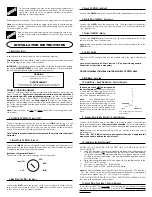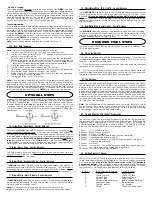
“No Tach
TM
” Starting
This starting method does not require the connection of the
GREEN
tach wire.
This method will start the car by reading the car’s voltage before attempting to
start, and then looking for a voltage increase when the alternator kicks in. This
feature automatically takes into account voltage, temperature, and the time
since the vehicle was last run. The “No-Tach
TM”
starting is preset at the factory
and you can skip step 13A if you would like to use it. Note that if the vehicle is
hard to start, set option #3 (step 23) for “extended crank.”
Tachometer sensing
If the vehicle is generally hard starting (requiring a cranking time of more than 1
second) you will get more accurate starting with the tachometer sensing start-
ing method. This method starts the car by reading the engine speed (tach)
information from a wire under the hood. If you choose tachometer sensing,
connect the
GREEN
(18 awg) wire to the car’s tach wire under the hood (nor-
mally the negative side of the coil or tach output of coil pack.) After you have
connected the
GREEN
wire, you need to teach the AutoCommand
®
the vehicle’s
tach rate at idle. Proceed to step 13A.
Note
:
You must have already initialized the module from Step 12.
13A. Tach Rate Learning
Note
:
Only use if the tachometer sensing method is chosen.
A.
Connect the GREEN wire to the car’s tach wire under the hood.
B.
Turn the On/Off control switch to the “OFF” position. Wait 5 seconds for the
flashing of the red LED to stop.
C.
Push the white “option” button once and you will see the red LED flash.
Now push the button on the transmitter for a few seconds until you see the
red LED flash again. You are now in TACH mode. (If the LED flashed twice
-- simply push the transmitter button again until you get only one flash).
D.
Wait 5 seconds for the red LED to flash 3 times.
E.
Turn the On/Off control switch back to the “ON” position
F.
Start the car and let it get to a
normal
idle. Do not press on the gas pedal.
G.
Push the red “code” button to the right of the red LED.
H.
Watch the red LED. It will turn on (solidly) after 3 or 4 seconds, indicating
that the idle rate has been learned.
I.
Turn the key to the “Lock/Off” position.
Note
:
Once this step is complete, the red LED should remain lit even when the
engine is running (at up to twice the learned idle rate--above this rate the LED
light should shut off). THIS IS CRITICAL. Confirm this by running the engine (with
the key in the ignition) and pressing the gas pedal to raise the idle rate to twice
the normal rate. The red LED should turn off. If it does not turn off, repeat the
tach rate learning step and check the
GREEN
wire connection and location.
OPTIONAL STEPS
Many of the optional steps require a relay to be hooked up. The most common
relay used for this type application is the Bosch type relay. Use the diagram
below for a typical hookup. If you have another relay then you need to know
that pins 85 and 86 in this diagram relate to the coils of the relay. Pin 30 is the
‘common’, and pin 87 is the ‘normally open’ contact. If your relay has a pin
87A it is not used. (The diagram below is typical for headlamp or parking light
applications).
14. Yellow Wire - Headlights - Control Harness
Connect the
YELLOW
wire which is optional, if your want to activate the low
beam headlights or parking lights. After the AutoCommand
®
has started the
car, the lights will remain on until the system shuts off after 10 minutes, or when
the brake pedal is pressed, or when the key is inserted into the ignition and the
car is put into gear.
This is a 400 mA transistor ground output which MUST drive a
relay
(not included). Connect the
YELLOW
wire to a relay that powers the lights
for this feature. If you are going to choose the Day Time Running Light option
(See Step 23) then hook this wire up to the low beam wire.
15. Blue - Horn / Siren - Control Harness
This wire which is optional, signals the horn to honk once each time the
AutoCommand
®
starts the car.
This is a 400 mA transistor ground output which
MUST drive a relay
(not included).
16. Brown Wire - Accessory Pulse - Control Harness
The
BROWN
wire which is optional, is the Accessory Pulse output which gives out a
transistor ground output just as the Accessory wire comes on. This is important in
unusual vehicles to control the defroster or to control the GM R.A.P. system.
Again,
this is a 400 mA transistor ground output which MUST drive a relay
(not included).
17. Brown/White - Alarm Disable - Control Harness
The
BROWN/WHITE
wire which is optional, will put out a quick negative pulse just
before starting the vehicle. This wire can be used to turn off the factory alarm
system in vehicles that have them.
Note
:
On most vehicles, this wire can be connected directly to the
factory alarm/disarm wire which is usually located in the driver's kick panel.
18. White/Black Wire - IGN 3 / VATS - Control Harness
The
WHITE/BLACK
wire which is optional, is a 400 mA transistor ground output
that acts just like the IGN1 or IGN2 relay outputs (active in the “run” and “crank”
positions).
This wire is a negative transistor output and MUST be set up to power a
relay
(not included). It can be used to power the third ignition wire at the
ignition key (necessary for vehicles such as: Lincoln Continental, Town Car, and
Grand Marquis).
19. Red/White Wire - Remote Input - Control Harness
The
RED/WHITE
wire which is optional, can be used to trigger the AutoCommand
®
to start from a source other than DesignTech’s remote control transmitter. Giving
this wire a negative pulse will cause the AutoCommand
®
to start. Giving it
another negative pulse will cause it to stop.
REQUIRED FINAL STEPS
You must have hooked up all required wires and completed Initialization (Step
12) to proceed forward.
20. Trying the Unit Out
WARNING: Be prepared to apply the brake during this testing. Close the hood,
fully apply the emergency brake, and place the vehicle in Park. Turn the On/Off
switch on -- the red LED will flash once.
A.
Once all the wiring is checked and is correct, put the car in park, then press
the button on the transmitter.
B.
The car should start and continue to run for ten minutes. Please make sure
that the engine shuts down if the car is taken out of park, the hood is opened,
the brake is pressed or the transmitter button is pushed again.
21. The Antenna
Snake the coax antenna around under the dash and up the inside of the right or
left windshield post and over the top of the windshield. Use the 2 enclosed
antenna clips to mount the last clear eight inches behind the rear view mirror
and two inches below the metal of the car. Clean the windshield with the
alcohol pad provided for maximum adhesion. Use the 2 double stick foam tape
pieces to mount the antenna clips. The better exposed the clear tube section
of the antenna is the better the range performance. Now Plug the end of the
antenna into the AutoCommand
®
Module. In many vehicles, you can get bet-
ter range performance by mounting the antenna vertically hanging downward
from the top of the windshield.
Note
:
The wiring section of the installation is now complete. Be sure to cap all
unused wires so as to prevent short circuits, and mount the module securely
under the dash. When tying up and mounting, be sure to avoid any moving
parts (steering column, pedals) and sharp edges.
22. Trouble Shooting with the Self Diagnostics
The AutoCommand
®
contains a built in diagnostic routine that will indicate why
the unit turned off the car the last time that the unit was used. To activate the
diagnostic mode, simply turn the On/Off control switch to the “OFF” position. In
a few seconds, the red LED on the module will flash 1 to 8 times to identify the
problem. See the chart below for an explanation of the flashes:
1
flash
10/15 minute time out
2
flashes
Brake or Hood activated
3
flashes
No Tach or Stalled.
4
flashes
Received another remote input from the transmitter
5
flashes
Transmission was shifted into gear
6
flashes
Low battery voltage, or may be missing an ignition wire which
powers up the alternator
7
flashes
Not Used
8
flashes
Over current - One of the transistor ouputs is driving too much cur-
rent. Make sure to use a relay where necessary.
12
flashes
The Control Switch was turned off.
23. Setting Program Options:
The AutoCommand
®
unit has 8 special options and features. You will not need
to use these special options in most situations. The factory settings will operate
most vehicles.
You must turn the On/Off control switch to the “OFF” position to
program any features.
Note that when turning off this control switch, the red LED
will flash a few times, giving the diagnostic code described in Section 22. Wait a
few seconds for it to finish before programming your new Options.
Feature #
Factory Setting (2 flashes) Option (1 flash)
1
“No-Tach”
Tach Mode
2
10 min. run time
15 min. run time
3
Normal Crank
Extended Crank
4
Normal Crank
Super Crank
5
Normal Voltage Metering
Ignore Voltage Metering
6
Gasoline vehicles
Diesel vehicles
7
“Enable” feature
No “Enable”
8
Normal
Daytime Running Lights






















